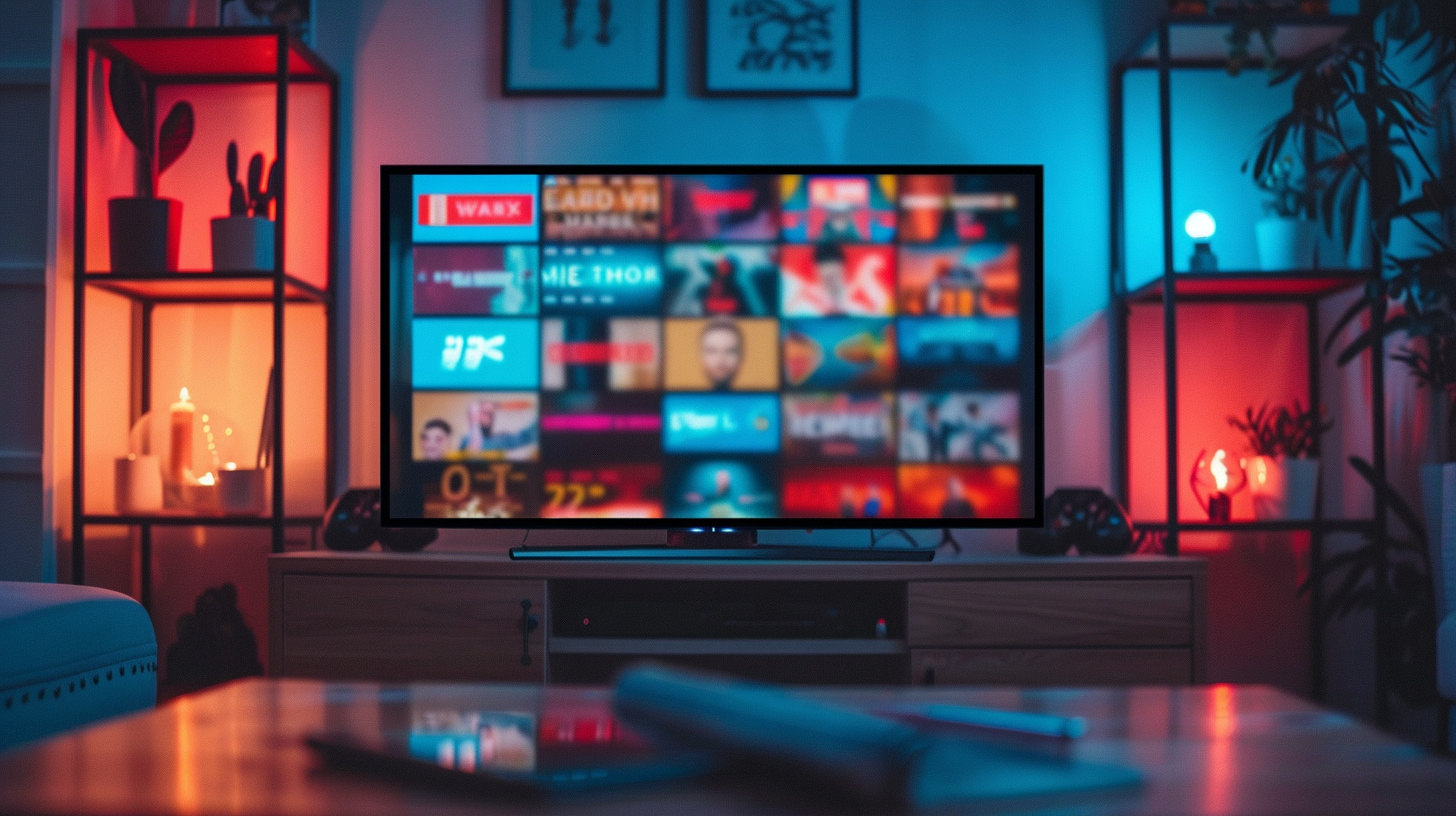Table of Contents Show
While some argue that the streaming wars have merely saturated our viewing options, we believe they’ve fundamentally transformed the landscape of entertainment, making it more diverse and accessible than ever before. As we navigate through the rise of streaming platforms, the pioneers who’ve reshaped our viewing habits, and the major players who dominate the scene, it’s clear that this revolution is not just about quantity. Traditional TV’s attempt to adapt, the binge-watching culture, and the shifting economic and legal sands promise a future of entertainment that’s both exciting and uncertain. Join us as we explore how these changes are empowering audiences, reshaping storytelling, and setting the stage for what’s next.
Key Takeaways
- Streaming platforms have revolutionized content consumption, offering viewers complete control over what and when they watch.
- Exclusive content battles and investments in original series intensify competition among platforms.
- Viewer habits have evolved towards binge-watching and personalized experiences, influenced by algorithm-driven recommendations.
- The rise of streaming services has led to economic and legal challenges for traditional TV and prompted a shift towards more diverse content libraries.
The Rise of Streaming
In the last decade, we’ve witnessed the meteoric rise of streaming platforms, revolutionizing how we access and consume entertainment. Gone are the days when we were at the mercy of cable TV schedules or the limited selection at the local video rental store. Now, we’re in the driver’s seat, choosing what to watch, when to watch it, and on what device. It’s a level of freedom and convenience we’d only dreamed of.
Streaming has not just changed the game; it’s completely rewritten the rules. We’re no longer tied down by geographical boundaries. A show produced in one corner of the world can be instantly available across the globe, broadening our horizons and introducing us to cultures and stories we might never have encountered otherwise. This global exchange of content has fostered a more interconnected world, where entertainment is a universal language.
Additionally, the rise of streaming has democratized content creation. Suddenly, anyone with a story to tell has the potential to reach millions. This has led to a surge in diverse, innovative content that traditional networks often overlooked. We’re seeing stories that reflect a wider array of experiences and perspectives, enriching our viewing experience and challenging us to think differently.
As we embrace this era of streaming, we’re not just passive consumers; we’re active participants in a cultural shift. We’re exploring new worlds, meeting new characters, and experiencing stories that resonate on a personal level. The rise of streaming isn’t just about convenience; it’s about freedom—the freedom to explore, to discover, and to be endlessly entertained on our own terms.
Pioneers of the Revolution
As we explore the pioneers of the streaming revolution, it’s fundamental to acknowledge the early giants that paved the way. Their innovative platforms drastically shifted our viewing habits, transforming how we consume entertainment today. Let’s examine how these trailblazers have reshaped the landscape of media consumption.
Early Streaming Giants
Several pioneering platforms radically transformed how we consume media, leading the revolution in streaming entertainment. These early giants didn’t just change the game; they rewrote the rules, offering us unprecedented freedom to watch what we want, when we want.
- Netflix: Started as a DVD rental service, quickly pivoted to streaming, becoming the household name for entertainment on demand.
- YouTube: Gave everyone a voice and a platform, turning video sharing into a global phenomenon.
- Hulu: Emerged as a joint venture among major media players, offering both current and past TV shows.
- Amazon Prime Video: Expanded from an online marketplace to a key player in streaming, adding movies and original content to its arsenal.
Each of these platforms has played an important role in empowering us to dictate our viewing experiences, setting the stage for an era of boundless viewing possibilities.
Shift in Viewing Habits
With the rise of early streaming giants, our viewing habits have undergone a significant transformation, steering us towards a more personalized entertainment experience. We’re no longer tied down by schedules or limited by choices. Instead, we’ve embraced a world where what we watch, when we watch, and how we watch is entirely up to us.
| Era | Viewing Habits | Freedom Gained |
|---|---|---|
| Pre-streaming | Scheduled programs | Limited |
| Early Streaming | On-demand selection | High |
| Current | Personalized recommendations | Unprecedented |
| Future | Interactive content | Boundless |
This table encapsulates the evolution of our viewing freedom, highlighting how far we’ve come and hinting at the endless possibilities ahead.
Major Players Emerge
We’ve often noticed that a few streaming platforms consistently stand out among the rest, shaping the digital entertainment landscape. These platforms not only offer us an extensive library of content but also grant us the freedom to watch our favorite shows and movies whenever we want. It’s a liberating shift from the rigid schedules of traditional TV.
The emergence of major players in the streaming market has revolutionized our viewing experience. Here’s a look at some of the frontrunners:
- Netflix: With its vast selection of movies, TV shows, and original content, Netflix remains a powerhouse in the streaming world. It’s our go-to for binge-watching.
- Amazon Prime Video: Offering a mix of movies, TV shows, and Amazon Originals, Prime Video also gives us the added perk of Amazon Prime membership benefits.
- Disney+: Catering to fans of Disney, Pixar, Marvel, Star Wars, and National Geographic, Disney+ has quickly become a favorite for families and fans of these franchises.
- HBO Max: Known for high-quality original series, movies, and access to HBO’s extensive library, HBO Max offers content that often becomes the topic of our water cooler conversations.
These platforms have not only changed what we watch but how we watch it. We’re no longer tied to the schedules set by traditional TV networks. Instead, we’re free to explore a vast world of digital content, tailor our viewing schedules to our lifestyles, and enjoy entertainment on our terms. It’s clear that as these major players continue to evolve, so too will our viewing habits and preferences.
Traditional TV’s Response
Acknowledging the rise of streaming giants, traditional TV networks have started to adapt their strategies to stay relevant in the ever-changing entertainment landscape. They’re not plunging headfirst; they’re reshaping the way we’ve always experienced TV. We’re seeing them venture into the digital world, launching their own streaming services or partnering with existing ones to guarantee their content is where we want it, when we want it. It’s a bold move to capture our attention and keep us hooked.
They’re also experimenting with content, pushing boundaries to compete with the edgy, original programming that’s become the hallmark of streaming platforms. Traditional networks are investing more in high-quality, compelling stories that can stand shoulder to shoulder with the best of streaming. They’re keenly aware that to win our viewership, they’ve got to offer something extraordinary.
Furthermore, we’re witnessing a more flexible approach to viewing schedules. Gone are the days of rigid TV timetables. Now, they’re offering on-demand options and even dabbling in releasing entire seasons at once, acknowledging our desire for control over what we watch and when. It’s a clear nod to the freedom that streaming services have long offered, and it’s a game-changer.
Ultimately, traditional TV’s response to the streaming wars isn’t just about survival; it’s about evolution. They’re reinventing themselves to meet us where we are, offering the freedom and quality we demand. It’s a thrilling time to be a viewer, as we stand at the crossroads of an entertainment revolution.
The Binge-Watching Phenomenon
As we turn our attention to the binge-watching phenomenon, it’s clear that our viewing habits have undergone a significant transformation. The way content is created has been directly impacted, aiming to keep viewers hooked for longer periods. We’ll also explore the psychological effects of this trend, questioning how it shapes our engagement with digital media.
Evolution of Viewing Habits
The rise of streaming platforms has fundamentally transformed our viewing habits, ushering in the era of binge-watching. We’ve shifted from waiting keenly for weekly episodes to consuming whole seasons in one sitting. This change reflects our desire for freedom in how and when we watch our favorite shows.
Here’s how our habits have evolved:
- Choice Overload: We’re faced with an abundance of choices, leading us to spend more time deciding than actually watching.
- Instant Gratification: We crave immediate satisfaction, and streaming services cater to this by releasing entire seasons at once.
- Flexible Viewing Schedules: We watch on our own terms, pausing and resuming as our schedules allow.
- Social Viewing Shifts: Traditional TV viewing was a communal activity. Now, we’re more likely to discuss shows online than watch them together.
Impact on Content Creation
Understanding how our viewing habits have evolved, it’s clear that streaming platforms have also drastically altered the landscape of content creation. We’ve embraced the freedom to choose what we watch and when we watch it, pushing creators to innovate how stories are told. Series are now crafted for binge-watching, with story arcs that span entire seasons, making every episode a piece of a larger puzzle.
| Emotion | Impact |
|---|---|
| Excitement | Endless new worlds to explore |
| Anticipation | Waiting for the next big release |
| Curiosity | Discovering unique, untold stories |
| Satisfaction | Completing a series in one go |
This shift gives us the power to dive deep into content we love, whenever we want, transforming passive viewing into an active, immersive experience.
Psychological Effects Explored
We’re now delving into how binge-watching, a hallmark of modern streaming culture, impacts our psychological well-being. It’s essential we comprehend the psychological effects of this phenomenon:
- Increases feelings of loneliness and isolation: Spending hours alone with only screens for company can heighten our sense of solitude.
- Disrupts sleep patterns: The allure of ‘just one more episode’ can lead to significant sleep deprivation.
- Triggers addictive behaviors: The endless content loop can foster compulsive watching habits.
- Affects mental health: Extended screen time has been linked to increased anxiety and depression symptoms.
Exclusive Content Battles
Often, streaming platforms fiercely compete to secure exclusive content, aiming to attract and retain subscribers. This relentless pursuit has drastically changed what we watch, pushing us towards a landscape where our favorite shows and movies are scattered across various services. We’re witnessing a battle that doesn’t just influence our viewing choices but also how freely we can access diverse content.
In this scramble for exclusivity, we’ve seen platforms like Netflix, Amazon Prime, and Disney+ pour billions into original series and films. They’re not just buying rights; they’re creating worlds that exist solely within their digital borders. This strategy, while enriching their libraries, often forces us into tough decisions about where to invest our time and money.
We’re all too familiar with the frustration of discovering a much-hyped show is only available on a platform we don’t subscribe to. It’s a deliberate tactic, designed to lure us into expanding our subscription list. But here’s where we find our freedom: in choosing what truly deserves our attention and resources. We’re not just passive consumers; we’re active participants, deciding which platforms align with our values and interests.
This competition has a silver lining. It drives innovation and quality, making sure platforms can’t just rest on their laurels. They’ve got to continuously offer something new and captivating, ensuring we, the viewers, always have something worth our time. In this battle for exclusivity, it’s clear we’re the ones with the real power, shaping the future of streaming with every choice we make.
Global Expansion Strategies
As streaming platforms aim to capture audiences worldwide, they’re embracing strategies that go beyond mere translation of content. We’re seeing a significant shift towards investing in local content, which not only resonates with regional audiences but also adds a rich diversity to their global catalog. Additionally, forming partnerships and acquiring local media companies are becoming key moves to establish a strong presence in new markets.
Local Content Investment
To expand their global reach, streaming platforms are increasingly investing in local content. This strategic move not only diversifies their offerings but also deeply resonates with audiences craving authentic storytelling from their own cultural backdrop. Here’s why we’re all for it:
- Authenticity: Local shows and films bring genuine stories and traditions to the forefront.
- Diversity: This approach enriches the platform with a variety of languages, genres, and narratives.
- Support for Local Talent: It opens doors for local actors, directors, and crew, spotlighting homegrown talent.
- Cultural Exchange: Audiences worldwide gain exposure to different cultures, fostering a greater understanding and appreciation.
Partnership and Acquisition Moves
Building on their commitment to local content, streaming platforms are now forging partnerships and making strategic acquisitions to further their global expansion. We’re witnessing a bold move towards a world where our screens reflect a rich tapestry of global cultures. By collaborating with local creators and buying into regional media companies, they’re not just entering new markets; they’re embracing them. This isn’t about domination—it’s about freedom of choice for us, the viewers. We get to explore stories from corners of the globe we’ve never even thought about, all from our living room. It’s a win-win: platforms grow their audience, and we’re liberated from the constraints of traditional media, diving headfirst into a boundless ocean of content.
Cutting-Edge Technology
Streaming platforms are leveraging cutting-edge technology to redefine how we experience entertainment. They’re not just changing what we watch; they’re revolutionizing how we access it. By embracing the latest advancements, these platforms guarantee we’re no longer tethered to traditional broadcast schedules or limited by geographical boundaries. This shift towards a more liberated viewing experience is driven by several key technological innovations:
- Cloud-Based Services: These allow us to stream content from anywhere, freeing us from the constraints of physical media and device storage limits.
- AI and Machine Learning: By analyzing our viewing habits, streaming platforms can offer personalized recommendations, ensuring we discover content that resonates with our tastes.
- High-Efficiency Video Coding (HEVC): This technology compresses video files without losing quality, enabling us to enjoy high-definition content even on lower bandwidths, making buffering a relic of the past.
- Blockchain and Digital Rights Management (DRM): Innovative use of blockchain technology guarantees content creators are fairly compensated while DRM keeps content secure, balancing freedom with responsibility.
These technologies collectively empower us to explore a vast universe of content on our terms, making us active participants in the entertainment landscape rather than passive consumers. We’re witnessing an era where our freedom to choose, discover, and enjoy content is unparalleled, thanks to these technological advancements. Streaming platforms, by harnessing these innovations, are not just part of the entertainment industry; they’re leading its evolution.
Viewer Experience Redefined
With these technological advancements in place, our viewing experience has fundamentally changed, offering us unprecedented control over what, when, and how we watch. Gone are the days when we were at the mercy of network schedules or limited by physical media. Now, it’s all about streaming our favorite shows and movies on demand, from anywhere, and on any device. We’re no longer passive viewers but active participants in curating our entertainment experience.
This shift has empowered us to break free from traditional viewing constraints. We’re no longer tied to a TV schedule; we watch what we want when we want it. This freedom has led to a more personalized viewing experience, with algorithms suggesting content based on our preferences and viewing history. It’s like having a personal TV guide that knows exactly what we love and introduces us to new favorites.
Furthermore, the social aspect of watching TV has been transformed. We can easily share what we’re watching with friends or join global conversations about the latest binge-worthy series. Streaming platforms have also made international content more accessible, broadening our horizons and introducing us to diverse cultures and stories.
Economic Impacts
Beyond transforming our viewing habits, the rise of streaming platforms has significantly impacted the economy, altering how money flows in the entertainment industry. We’re seeing a seismic shift in how content is produced, distributed, and monetized, leading to both opportunities and challenges for creators and consumers alike. Here’s a quick exploration into the economic impacts:
- Traditional TV ad revenues are dwindling as advertisers flock to streaming services, chasing after our eyeballs with more targeted and interactive ad experiences.
- Content creators have more avenues to monetize their work, from direct subscriptions to exclusive deals with platforms, giving them the freedom to experiment and innovate.
- The barriers to entry for new creators are lower, democratizing content production and enabling a wider range of voices and stories to emerge.
- Competition among platforms is driving massive investments in original content, pumping billions of dollars into the creative economy and providing us with an unprecedented variety of entertainment options.
This transformation is reshaping the entertainment landscape in profound ways. We’re not just passive consumers anymore; we’re active participants in a rapidly evolving ecosystem that values choice, diversity, and accessibility. The economic impacts of streaming platforms are creating a new world of opportunities for us to explore, connect, and engage with content that resonates on a personal level. It’s about more than just watching; it’s about experiencing stories in a way that feels liberating and empowering. As we navigate this change, it’s clear that our freedom to choose what, how, and when we watch is at the heart of this revolution.
Legal and Regulatory Challenges
As we explore the economic impacts of streaming platforms, it’s equally important to address the legal and regulatory challenges they introduce. These challenges aren’t just minor speed bumps; they’re significant hurdles that we need to guarantee and navigate to make sure our freedom to choose and watch content remains unaffected.
Streaming platforms have disrupted traditional media landscapes, leading to a complex web of legal issues. These include copyright disputes, data privacy concerns, and the need for new regulations that keep pace with technological advancements. We’re at a crossroads, where the future of our digital consumption hangs in the balance, influenced by decisions made in courtrooms and government offices around the world.
To engage you further, here’s a table summarizing the key legal and regulatory challenges:
| Challenge | Description | Impact on Freedom |
|---|---|---|
| Copyright Law | Protects creators but complicates access to content. | Limits what we can watch. |
| Data Privacy | Concerns over how platforms use our data. | Affects our digital autonomy. |
| Licensing | Geographic restrictions on content. | Restricts our access globally. |
| Net Neutrality | Ensures equal access to all online content. | Threatened by ISP control. |
| Regulation | Governments may impose strict controls. | Could limit platform innovation. |
We’re advocating for a balanced approach that respects both creators’ rights and our freedom as consumers. It’s a delicate dance between protecting intellectual property and ensuring open access to content. As these platforms continue to evolve, so too must our understanding and responses to these legal and regulatory challenges.
Future of Entertainment
The future of entertainment is being reshaped by streaming platforms, leading us into a new era of digital consumption. As we navigate this shift, we’re not just passive observers; we’re active participants in a revolution that promises more freedom in what, how, and when we watch. Streaming services are breaking down traditional barriers, offering a plethora of content that was once beyond our reach. Here’s what we can look forward to:
- Personalized Viewing Experiences: Tailored content recommendations based on our viewing habits mean we’re less likely to waste time scrolling and more time enjoying.
- Diverse Content Libraries: From niche indie films to foreign dramas, streaming platforms are broadening our horizons and challenging our tastes.
- Flexible Viewing Schedules: Gone are the days of scheduling our lives around TV timetables. We watch on our terms, pausing and resuming as life demands.
- Innovative Content Formats: Expect more interactive and immersive experiences, blurring the lines between viewers and creators.
In this evolving landscape, we’re inching closer to a truly liberated entertainment experience. Streaming platforms are not just changing the game; they’re crafting a new playing field where freedom and choice reign supreme. As we look to the future, it’s clear that these platforms will continue to push boundaries, ensuring that our entertainment experiences are as boundless as our imaginations. Let’s embrace this shift, exploring the vast possibilities that lie ahead, in a world where we’re no longer just spectators but co-creators of our entertainment destiny.
Audience Power Shift
Streaming platforms have greatly shifted power into the hands of viewers, allowing us to curate our entertainment experiences like never before. Gone are the days when we had to adhere to the rigid schedules of traditional TV. Now, we’re in charge, deciding not only what but when and how we watch. This revolution has handed us unprecedented control, turning passive viewership into an active, personalized journey.
We’ve seen firsthand how our choices directly influence what gets produced. Shows that might have been canceled too soon on traditional networks find new life and even cult status on streaming platforms, thanks to our vocal demand and binge-watching habits. This shift is a clear signal that we’re not just spectators; we’re significant influencers in the entertainment landscape.
Here’s a quick look at the aspects of our newfound power:
| Aspect | Description | Impact on Entertainment |
|---|---|---|
| Choice | Unlimited selection of content | Tailored viewing experiences |
| Accessibility | Watch anytime, anywhere on various devices | Convenience and flexibility |
| Interaction | Social media and review platforms allow us to share opinions and influence | Greater viewer influence |
| Customization | Algorithms suggest content based on preferences | More relevant and engaging content |
| Feedback Mechanisms | Direct feedback channels to creators and platforms | Viewer preferences shape future content |
Our voices matter more than ever, and we’re not afraid to use them. We’re not just watching; we’re participating, shaping the future of entertainment to align with our desires for freedom and personalized content. The power shift towards us, the audience, is both liberating and empowering, ensuring that our entertainment universe is ever-expanding and evolving, just the way we like it.
Conclusion
To sum up, we’ve navigated the turbulent seas of the streaming wars, witnessing a seismic shift in our viewing habits. Traditional TV’s struggling to keep pace, while streaming giants dictate the rhythm of our binge-watches. This revolution’s not just reshaping entertainment; it’s handing us the remote control, empowering us to curate our viewing odyssey. As we sail into the future, one thing’s clear: in the streaming wars, the viewer is king, charting the course of what’s next on the horizon.








